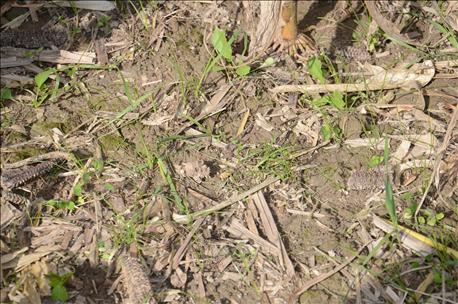
You’ve likely read success stories from individual farmers who use cover crops. It’s easy to find stories with tips about growing cover crops successfully. Farmers are willing to share information because they want those who haven’t tried covers yet to have a good experience. But is there proof that cover crops are catching on statewide?

MORE COVER CROPS: Conservation partners are finding more acres in cover crops when they conduct tillage surveys. However, there are still millions of acres not in cover crops.
The answer is yes, says Becky Fletcher, communications specialist with the Natural Resources Conservation Service. She recently reminded everyone that the Indiana Conservation Partnership does something not done in all states. Members work together to conduct transect studies to determine how many acres are in minimum-tillage and no-till systems. In recent years, they have also recorded the number of cover crops acres.
The partnership consists of NRCS, the Indiana State Department of Agriculture through the Division of Soil Conservation, soil and water conservation districts at local and state levels, Purdue University Extension, and the Farm Service Agency.
One of the NRCS specialists who works with the Indiana Conservation Partnership is Shannon Zezula, NRCS state resource conservationist. He notes that cover crops are definitely catching on with Indiana farmers. The latest transect study proves this.
Transect method
Zezula explains that a transect study is a drive-by study of an entire county conducted by conservation team members working together. The goal is to drive an area, usually a county, on a predetermined route, and check various fields at random. “It’s a statistically valid method that began in the 1990s,” he says.
Results of Indiana’s spring transect study in 2016 show Indiana farmers planted over 1.1 million acres of cover crops a year ago that were in place this spring. “That’s an increase of over 400% since 2011," Zezula says.
Hoosier farmers are definitely leading the nation in soil health management systems that include cover crops, he emphasizes.
Room for improvement
Despite the tremendous growth in cover crops, there is still plenty of room for expansion in cover crop use. According to ISDA’s Division of Soil Conservation website, still only about 10% of Indiana’s corn and soybean combined acreage was planted to a cover crop in the fall of 2015.
But that number was about 2% in 2011, and the growth is reason for excitement. If you’re someone who believes in cover crops, the 90% of corn and soybean acres that still isn't covered with cover crops each fall makes what military folks call a "target-rich environment." Translated, that means there are still many more acres that could be planted to cover crops in Indiana each fall. Read the transect data on cover crops.
No-till trends
The increase in cover crops is tied to how many farmers no-till and/or don’t disturb residue in the fall after harvest. The latest transect found that 34% of all statewide corn acres and residues were undisturbed last fall. That amounts to 1,621,000 acres.
The same study shows that 59% of soybean acres weren’t disturbed. That amounts to 2,841,600 acres.
The trend for combined no-till acres in Indiana increased sharply from 1990 to 2000, and while leveling out more recently, it increased again last year.
About the Author(s)
You May Also Like




